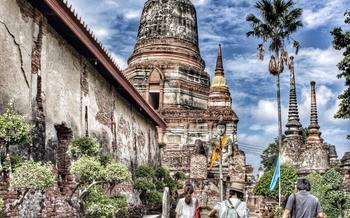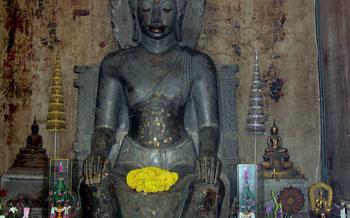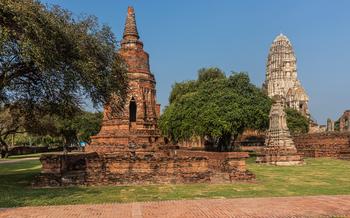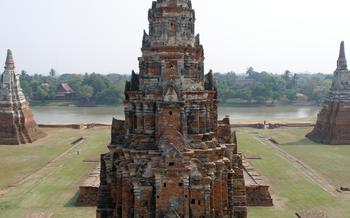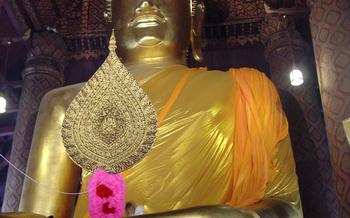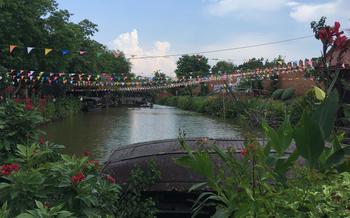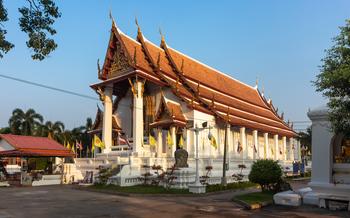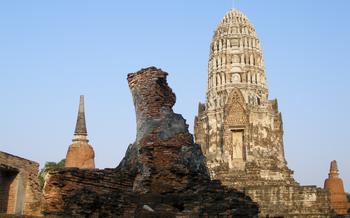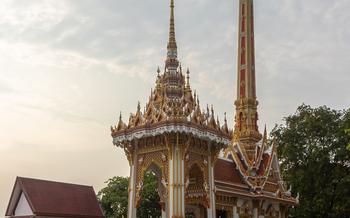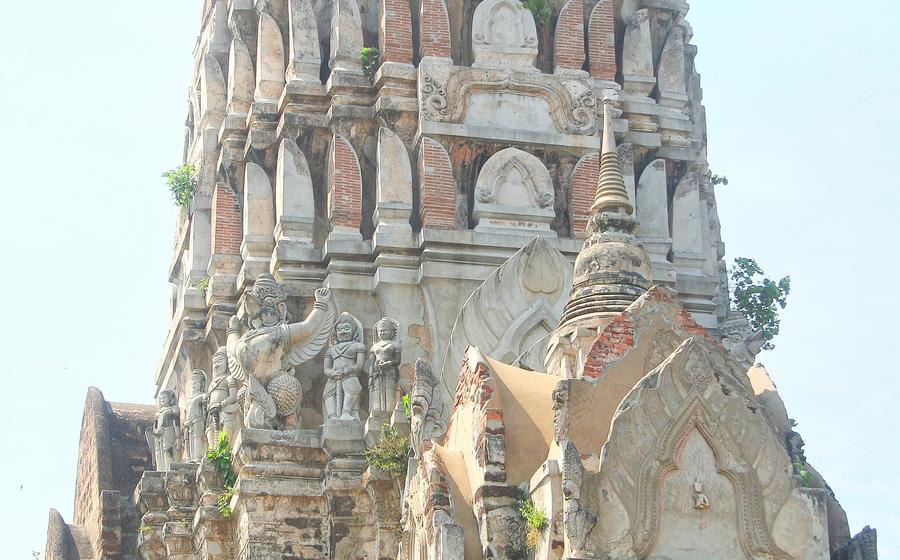
Wat Yai Chaimongkol
- History and Significance of the Temple
- Exploring the Temple Grounds
- The Ordination Hall (Ubosot)
- The Reclining Buddha Image
- The Surrounding Monastery
- The Temple Market
- Festivals and Events
- Getting There and Away
- Transportation Options to Ayutthaya from Bangkok
- Directions to Wat Yai Chaimongkol from the City Center
- On-site Parking and Accessibility for Visitors
- Length of Visit and Suggested Itineraries
- Best Time to Visit
- Photography and Videography
- Local Cuisine and Dining
- Insider Tip: Hidden Gems
History and Significance of the Temple
Wat Yai Chaimongkol, also known as Wat Muang, is a significant Buddhist temple located in the ancient city of Ayutthaya, Thailand. Founded in 1357 during the reign of King Uthong, the first monarch of the Ayutthaya Kingdom, this temple holds immense historical and spiritual importance. It served as the royal temple for many Ayutthayan kings, including King Ramathibodi I, who expanded and renovated the temple in the 14th century. Over the centuries, Wat Yai Chaimongkol has undergone several restorations, preserving its grandeur and symbolic value to this day. The temple's name, which translates to "Great Temple of Victory," reflects its association with Ayutthaya's triumphs and its enduring legacy as a center of religious devotion and cultural heritage.
Exploring the Temple Grounds
The temple grounds of Wat Yai Chaimongkol are a sprawling complex of serene courtyards, glistening stupas, and intricate viharns (assembly halls). As you wander through the grounds, you'll be struck by the intricate details and harmonious arrangement of the buildings, each contributing to the overall grandeur of the temple.
Notable among these structures are the towering stupas, which rise majestically towards the sky. Their gleaming white spires, adorned with intricate carvings and colorful tiles, create a striking contrast against the lush greenery that surrounds them. These stupas serve as a reminder of the Buddha's teachings and the impermanence of all things.
The ordination hall, or ubosot, is the most sacred building within the temple complex. Its elegant architecture and ornate decorations reflect its importance as a place of Buddhist ceremonies and rituals. The interior walls are adorned with vibrant murals depicting scenes from the Buddha's life and teachings, offering visitors a glimpse into the rich mythology and history of Buddhism.
In addition to these main structures, the temple grounds are dotted with numerous viharns, which serve as meditation and assembly halls for the monks. These viharns are often adorned with intricate carvings and colorful paintings, each telling a unique story from Buddhist lore.
As you explore the temple grounds, take some time to appreciate the peaceful atmosphere and serene surroundings. The sound of birdsong and the gentle rustling of leaves create a tranquil ambiance, inviting you to slow down, reflect, and connect with your inner self.
The Ordination Hall (Ubosot)
In the heart of Wat Yai Chaimongkol, the Ubosot, or Ordination Hall, stands as a sacred space for significant Buddhist ceremonies. Constructed in a traditional architectural style, the Ubosot exudes an aura of serenity and devotion. Its distinctive features include a gracefully curved roof adorned with intricate carvings and a majestic entrance framed by elaborate pillars.
As a place of Buddhist ordinations, the Ubosot is imbued with profound spiritual significance. It is here that young men and women embark on their journey as monks or nuns, committing to a life of service and spiritual growth. The Ubosot's interior is adorned with exquisite murals depicting scenes from Buddhist teachings and stories, serving as visual narratives that inspire and guide the faithful.
During ordination ceremonies, the candidates for monkhood or nunhood gather within the Ubosot, surrounded by a congregation of witnesses. The ceremony is conducted by senior monks, who guide the candidates through the rituals and precepts that mark their entry into the monastic order. The air is filled with a sense of reverence and devotion as the candidates make their vows to follow the teachings of the Buddha and to uphold the principles of the monastic life.
Beyond its ceremonial significance, the Ubosot is also a place of meditation and prayer for the monks and laypeople alike. The peaceful atmosphere and serene surroundings encourage contemplation and spiritual reflection. Visitors are welcome to enter the Ubosot, observing the rituals and ceremonies with respect and humility, gaining a deeper understanding of the Buddhist faith and its traditions.
The Reclining Buddha Image
Within the temple grounds, visitors are drawn to the captivating sight of the reclining Buddha image, a serene representation of the Buddha in a state of deep meditation. Its sheer size and intricate details leave a lasting impression on all who behold it. The image, measuring an impressive 42 meters in length and 8 meters in height, is a testament to the artistry and devotion of the temple's builders.
The reclining Buddha, also known as the Phra Buddha Saiyas, exudes an aura of tranquility and serenity. Its peaceful posture, with the right hand supporting the head and the left hand resting gracefully along the body, invites visitors to pause and reflect. The image represents the Buddha's final moments before entering Parinirvana, the ultimate state of liberation from the cycle of rebirth.
In Buddhism, the reclining Buddha symbolizes the Buddha's teachings on impermanence and the futility of worldly attachments. It serves as a reminder that all things, including life itself, are subject to change and decay. Devotees offer prayers and make offerings to the reclining Buddha, seeking blessings, peace of mind, and guidance on their spiritual journey.
The reclining Buddha image at Wat Yai Chaimongkol is one of the most revered and iconic representations of the Buddha in Thailand. Its size, artistry, and religious significance make it a must-see for anyone visiting Ayutthaya.
The Surrounding Monastery
Within the temple complex, you'll find a bustling monastery that serves as the living quarters for the resident monks. This monastery is a sacred place where the monks devote themselves to studying, practicing, and teaching the Buddhist faith. Visitors are welcome to interact with the monks, who are known for their warmth and hospitality. You can observe their daily routines, engage in meaningful conversations, and learn more about the Buddhist way of life.
The monastery provides a glimpse into the monastic lifestyle, where simplicity, discipline, and spiritual growth are paramount. Visitors can witness the monks' daily activities, such as chanting prayers, meditating, and studying Buddhist scriptures. There are also opportunities to offer alms to the monks, a traditional practice that symbolizes respect and support for their dedication to the faith.
Through interactions with the monks, you can gain a deeper understanding of Buddhism and its teachings. Whether you're seeking spiritual guidance or simply curious about the monastic life, the monastery at Wat Yai Chaimongkol offers a unique opportunity for personal growth and cultural exchange.
The Temple Market
At the entrance of Wat Yai Chaimongkol, a vibrant and lively temple market greets visitors, offering a glimpse into the local culture and community. The market is a bustling hub of activity, where vendors display a variety of goods and souvenirs that are perfect for taking home as mementos of your visit. From colorful handmade crafts and intricate Buddha statues to traditional Thai clothing and accessories, there's something for everyone to find.
Bargaining is a common practice in Thai markets, so don't be afraid to negotiate prices with the friendly vendors. You can also find delicious local snacks and treats, such as fresh fruits, sweet desserts, and savory grilled meats, making the market a great place to grab a bite to eat while exploring the temple grounds.
By supporting the local vendors, you not only take home unique souvenirs but also contribute to the sustainability and preservation of Wat Yai Chaimongkol and the surrounding community. Embrace the vibrant atmosphere, engage with the friendly locals, and immerse yourself in the authentic Thai market experience.
Festivals and Events
Wat Yai Chaimongkol, like many other temples in Thailand, comes alive during annual temple fairs and celebrations. These events are a vibrant showcase of Thai culture, community spirit, and religious devotion. The most significant festival is the temple's annual "wai khru" ceremony, held in May. During this ceremony, monks and devotees pay homage to their teachers and express gratitude for their teachings. The temple grounds are adorned with colorful decorations, and there are lively processions, chanting, and offerings made to the Buddha images. Visitors can participate in traditional rituals, witness the spectacle, and immerse themselves in the festive atmosphere. Other festivals throughout the year include Songkran (Thai New Year), Visakha Bucha (Buddha's birthday), and Kathin (robe-offering ceremony), each with its unique significance and activities. Attending these festivals offers a chance to experience the temple's spiritual energy, connect with the local community, and gain a deeper understanding of Thai Buddhist traditions.
Getting There and Away
Transportation Options to Ayutthaya from Bangkok
Ayutthaya is conveniently located just a short distance from Bangkok, making it an ideal day trip or weekend getaway. There are several transportation options available to reach Ayutthaya from Bangkok, depending on your budget and preferences.
-
Train: The train is the most affordable and scenic option, offering panoramic views of the countryside. Trains depart from Bangkok's Hualamphong Station and take about 1-2 hours to reach Ayutthaya.
-
Bus: Buses are another budget-friendly option, with departures from Bangkok's Northern Bus Terminal (Mo Chit). The journey takes approximately 1-2 hours, depending on traffic.
-
Taxi or Private Car: For a more comfortable and direct journey, you can opt for a taxi or private car. The trip takes about 1-5 hours, depending on traffic conditions.
Directions to Wat Yai Chaimongkol from the City Center
Once in Ayutthaya, Wat Yai Chaimongkol is easily accessible from the city center. You can take a tuk-tuk or taxi from the Ayutthaya Railway Station or the bus station, which will cost around 50-100 baht. The temple is located about 2 kilometers from the city center, and the journey takes approximately 10-15 minutes.
On-site Parking and Accessibility for Visitors
Wat Yai Chaimongkol provides ample parking space for visitors, both for cars and tour buses. The parking area is located near the temple entrance, making it convenient for visitors to access the temple grounds. The temple is also wheelchair accessible, with ramps and designated parking spaces for visitors with disabilities.
Length of Visit and Suggested Itineraries
Depending on your interests and time constraints, you can spend anywhere from 1-2 hours exploring Wat Yai Chaimongkol. If you're short on time, focus on the main highlights, such as the Giant Buddha image, the reclining Buddha, and the ordination hall. For a more in-depth experience, take your time to wander around the temple grounds, admire the intricate details of the architecture, and soak in the serene atmosphere.
-
1-Hour Itinerary: Visit the Giant Buddha image, pay your respects, and take some photos. Then, head to the reclining Buddha and admire its impressive size. Finally, stop by the ordination hall to see the beautiful murals and learn about its significance.
-
2-Hour Itinerary: In addition to the 1-hour itinerary, explore the surrounding temple grounds, including the stupas, viharns, and other buildings. Take some time to admire the sculptures, murals, and other artistic elements that adorn the temple. You can also visit the temple market to purchase souvenirs and support the local community.
Best Time to Visit
The best time to visit Wat Yai Chaimongkol is during the cool and dry season, which runs from November to February. During this period, the weather is pleasant and sunny, making it ideal for exploring the temple grounds and admiring the intricate details of the architecture. The skies are often clear, providing ample opportunities to capture stunning photographs of the temple against a backdrop of blue skies and white clouds.
To avoid the crowds and enjoy a more tranquil experience, it is advisable to visit the temple early in the morning or late in the afternoon, as these are typically the quietest times. If possible, try to plan your visit on a weekday, as weekends tend to attract more local and international tourists.
If you are interested in witnessing special events or ceremonies, be sure to check the temple's calendar in advance. Some of the most notable festivals include Songkran, the Thai New Year, which takes place in April, and Visakha Bucha, which commemorates the birth, enlightenment, and passing of the Lord Buddha, and is celebrated in May. During these festivals, the temple is adorned with colorful decorations, and special ceremonies and processions are held, offering visitors a glimpse into the vibrant religious traditions of Thailand.
Photography and Videography
Capturing the essence of Wat Yai Chaimongkol through photography or videography is a meaningful way to preserve memories and share the temple's beauty with others. However, it's crucial to respect the sacredness of the site and adhere to appropriate guidelines.
Photography and videography are generally permitted within the temple grounds, but certain areas may be restricted. It's essential to observe signs and pay attention to requests from temple officials or monks. Always seek permission before photographing or filming any religious ceremonies or rituals.
Respecting the privacy of monks and other visitors is paramount. Avoid taking intrusive or disruptive photos or videos. Refrain from using flash photography, as it can be distracting and disrespectful during religious ceremonies.
Strive to capture the beauty and essence of the temple through your images. Experiment with different angles, lighting conditions, and compositions to showcase the temple's unique architectural features, intricate details, and serene atmosphere.
By following these guidelines and demonstrating cultural sensitivity, you can create stunning visual memories of your visit to Wat Yai Chaimongkol while respecting the temple's sacredness and the privacy of its visitors.
Local Cuisine and Dining
A visit to Wat Yai Chaimongkol can be complemented by a delicious culinary experience in Ayutthaya. The city offers a diverse range of restaurants and cafes, allowing you to immerse yourself in the authentic flavors of Thai cuisine.
Within walking distance of the temple, you'll find several local eateries serving up traditional dishes. For a taste of the famous boat noodles, head to one of the many riverside stalls or restaurants. These noodle soups, served in small bowls, are a local specialty and offer a burst of flavors from the rich broth and tender meat.
If you have a sweet tooth, don't miss out on the legendary mango sticky rice. This classic Thai dessert combines perfectly ripe mangoes with sweet, sticky rice, creating a harmonious balance of flavors and textures. Many street vendors and dessert shops offer this delectable treat throughout the city.
For those seeking vegetarian or vegan options, Ayutthaya has you covered. Several restaurants cater to plant-based diets, offering a variety of dishes that are both delicious and nutritious. From tofu curries to vegetable stir-fries, there are plenty of options to satisfy your taste buds.
As you savor the local cuisine, take the opportunity to engage with the friendly locals. They'll be delighted to share their culinary recommendations and provide insights into the unique flavors of Ayutthaya's cuisine. Embrace the vibrant atmosphere and enjoy a meal that will leave you with lasting memories of your visit to this historic city.
Insider Tip: Hidden Gems
Beyond the main attractions of Wat Yai Chaimongkol, there are hidden gems waiting to be discovered by curious explorers. Explore the tranquil gardens behind the ordination hall, where you'll find secluded corners perfect for meditation or quiet contemplation. Ascend the narrow staircase to the temple's rooftop terrace for a panoramic view of the surrounding countryside, with the gleaming spires of Ayutthaya's other temples piercing the horizon.
Seek out the lesser-known Buddha images scattered throughout the temple grounds. In a small pavilion near the reclining Buddha, you'll find a beautiful bronze image of the Buddha seated in the lotus position, exuding an aura of serenity. Another hidden treasure is the Emerald Buddha replica enshrined in a small alcove near the temple's entrance, a testament to the devotion and craftsmanship of the temple's artisans.
If you're fortunate enough to visit during a local festival or event, embrace the opportunity to immerse yourself in the vibrant Thai culture. Participate in traditional rituals, savor delicious local cuisine, and engage with the friendly monks and locals who will gladly share their stories and insights. These special moments offer a glimpse into the heart and soul of Wat Yai Chaimongkol and the community that surrounds it.
